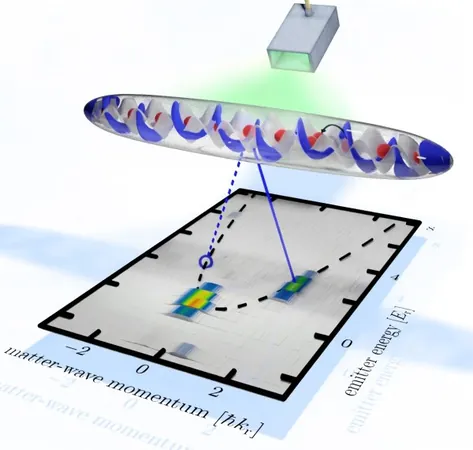
Revolutionary Discovery in Quantum Optics: Scientists Unleash Secrets of Matter Waves
2024-11-21
Author: Daniel
Introduction
In a groundbreaking development that could reshape our understanding of quantum phenomena, a research team at Stony Brook University, led by Professor Dominik Schneble, has unveiled a new regime for cooperative radiative phenomena. This discovery addresses a long-standing enigma in quantum optics that has puzzled scientists for over 70 years. The team’s exciting findings, which delve into uncharted collective spontaneous emission effects using synthetic atoms, have been published in the prestigious journal *Nature Physics*, alongside complementary theoretical insights in *Physical Review Research*.
Understanding Spontaneous Emission
Spontaneous emission occurs when an excited atom transitions to a lower energy state, releasing a quantum of electromagnetic radiation as a single photon. The traditional model, introduced by physicist R. H. Dicke in 1954, posited that if a second atom is close by, the chance of finding the first atom in its excited state—and its subsequent emission behavior—changes significantly. Remarkably, Dicke concluded that the presence of an additional atom could halve the probability of excitation, giving rise to complex phenomena like superradiance (enhanced emissions when atoms are in phase) and subradiance (suppressed emissions when out of phase).
Innovative Research Methodology
Schneble's innovative research utilized ultracold atoms arranged in a one-dimensional optical lattice, creating a unique environment for studying synthetic quantum emitters. Unlike traditional photons, which travel at light speed, the emitted matter waves in their experiments moved much slower, allowing the researchers to explore collective radiative phenomena in new regimes that were previously inaccessible.
Directional Collective Emission
By carefully designing and manipulating arrays of these emitters to exhibit both weakly and strongly interacting many-body excitation phases, the team successfully demonstrated directional collective emission. Their work illuminated the intricacies of retardation effects and the interplay between superradiant and subradiant dynamics—fascinating concepts that hold implications for quantum information science and technology.
Significance of the Findings
Schneble emphasized the significance of their findings for fields like quantum networks. “We can precisely manipulate subradiant states like never before, effectively pausing spontaneous emission and revealing where radiation resides within the array,” he explained. This innovation opens a pathway to better harness super- and subradiance in future quantum technologies, particularly in connected systems like one-dimensional waveguides.
Challenges in Tracking Radiation
Co-authors Youngshin Kim and Alfonso Lanuza expanded on this revolutionary study, noting the complexities involved in tracking slow radiation from a system of emitters. Lanuza likened the challenge to a game of catch and release, highlighting the intricate interactions that occur when multiple photons and atoms are engaged—where photons can be captured and exchanged or even become temporarily bound to excited atoms.
Mathematical Insights and Future Exploration
The research team's mathematical insights into managing these interactions pave the way for discovering yet more intricate patterns of collective atomic decay, indicating a vibrant area for future exploration.
Concluding Remarks
In conclusion, this pivotal research on collective radiative dynamics positions ultracold matter waves as a formidable tool for investigating many-body quantum optics within extended and ordered systems. With theoretical frameworks and experimental validations aligning, the Stony Brook team's findings could significantly propel advancements in quantum technologies, potentially leading to groundbreaking applications in quantum computing, communication, and sensing.
Acknowledgments
This remarkable work received support from the National Science Foundation and Stony Brook University's Center for Distributed Quantum Processing, highlighting the collaborative efforts advancing the frontiers of quantum science. As researchers continue to unravel the mysteries of quantum behavior, the implications for technology and our understanding of the universe are nothing short of awe-inspiring.



 Brasil (PT)
Brasil (PT)
 Canada (EN)
Canada (EN)
 Chile (ES)
Chile (ES)
 España (ES)
España (ES)
 France (FR)
France (FR)
 Hong Kong (EN)
Hong Kong (EN)
 Italia (IT)
Italia (IT)
 日本 (JA)
日本 (JA)
 Magyarország (HU)
Magyarország (HU)
 Norge (NO)
Norge (NO)
 Polska (PL)
Polska (PL)
 Schweiz (DE)
Schweiz (DE)
 Singapore (EN)
Singapore (EN)
 Sverige (SV)
Sverige (SV)
 Suomi (FI)
Suomi (FI)
 Türkiye (TR)
Türkiye (TR)